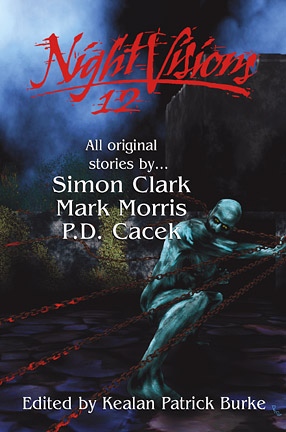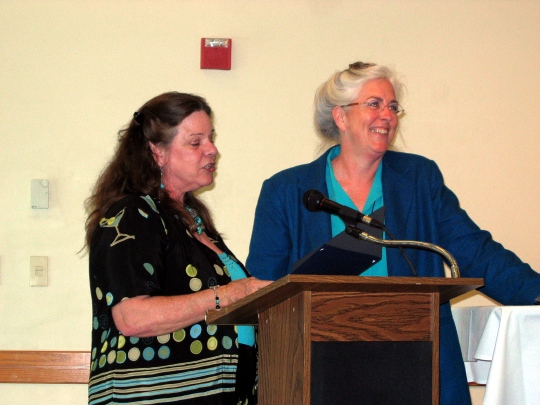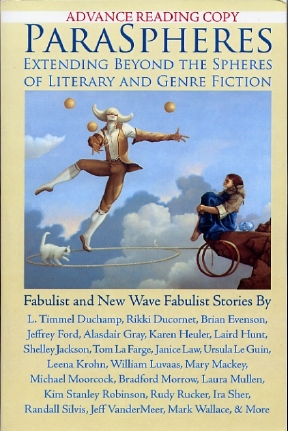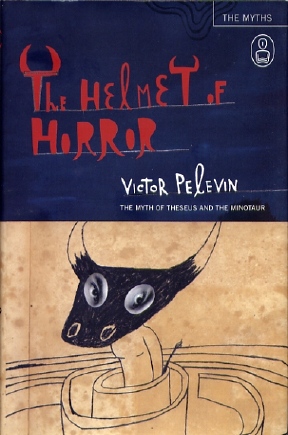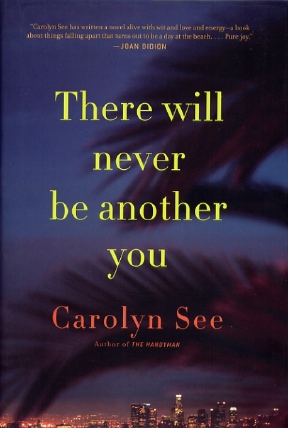|
|
|
This Just In...News from the Agony Column
|
05-26-06: Youth, Darkness and the Series Anthology |
|||
'Night
Visions 12' Edited by Kealan Patrick Burke
Oh my. Dating ourselves, are we? Back in 1984, when this august event came to pass, I was considerably older than eight. I was in the first flush of discovering just how many great books there were out there to be had, to be owned, to be read, and Dark Harvest was one of the big names in the small press. Now, alas, they are no more. But the series they created has been resurrected by Subterranean Press, and I couldn’t be happier. Scratch that. I could be happier. Back then, I was given to think that series such as 'Night Visions' might change the publishing landscape. Instead, it turns out that they were the change in the publishing landscape. Though the small presses are no longer so small, and the big publishers have become cosmically and comically large, the situation on the ground for the reader has remained pretty much the same. That is, if you want a theme anthology from the big press, you're lucky to get a mass-market paperback. And if you want something a bit finer, a bit edgier, you'll need to look for something like 'Night Visions'. 'Night Visions' hasn’t changed a lot in the intervening GENERATION, but frankly neither has America. Having won one Cold War, we've set off on another, and apparently there's still something left to trickle down; but don’t ask what. Still, if we're going to be stuck in a permanent 1984, at least we can enjoy our nightmares, and have them codified for us by professional dream transcribers, folks who have been in the biz well, if not for a generation, at least for longer the last TV season. Perhaps the most chilling aspect of 'Night Visions 12' is the youth of the editor. The essay that begins the collection is fascinating, well-written, enthusiastic and filled with descriptions that seem positively surreal. From the opening sentence to the editor's description of his first encounter with the 'Night Visions' series, Burke reminds us how easily the heritage of horror is taken for granted. The three authors he's selected -- Simon Clark, Mark Morris and P. D. Cacek are to me veteran writers. I remember quite distinctly reading 'Nailed by The Heart' and 'Toady' (AKA ';Horror School') when they first came out, and I have P. D. Cacek's first book in the weird little paperback version as well. So to read that Burke discovered Clark when he read 'Salt Snake and Other Stories', by which time Clark was on my auto-buy list, is oddly disjointing. This was, after all, a collection I had handed to my teenaged son to read. That said, Burke is to be commended for his choices, which, if not exactly new, are still quite excellent. Clarke, who started his life-in-death as something of a slash-and-burner hasn’t exactly mellowed with age, but he offers a welcome perspective with three tales that refer the reader back some three, four or maybe even five generations of horror fiction. "My God, My God" references William Hope Hodgson a figure of primal interest whose work is being resurrected by Night Shade Books. "Poe, Lovecraft, Jackson" is about as close to a Holy Trinity of Classic Horror as one can come, leaving out only Mary Shelley, who gets hers in "Frankenstein, Victor". Mark Morris has long been one of my favorites, since I discovered 'Horror School' back in the day. I loved that book enough to track down the original paperback and hardcover versions, under the UK title of 'Toady'. Continuing a sort-of theme of work referring to past horror fiction, "Feeding Frenzy" brings the pulps to an unpleasant life. You keep waiting for someone to say, "Next stop, Willoughbuy," in Morris' "What Nature Abhors." Man in a train station? I practically lived with that episode of "The Twilight Zone" when I was in college. The positively joyous denial of reality flew in the face of the usual gloom-and-doom of one's college years. Morris sticks with the gloom-and-doom to his credit, glooming and dooming the reader into a wish-you-weren't here state of mind. "The Story April and her Colors" is classic Morris work; here be monsters. P. D. Cacek takes fullest advantage of the 'Night Visions' format with a novella-length multiple-personality thriller titled 'Forced Perspective'. Frankly, in a perfect world, it would be its own deal in a nice MMPB, or even a standalone hardcover. This being the world we have, at least there is still someone around to offer Cacek the space to do as she pleases. 'Campfire Story' concludes the volume with an appropriately classic take on the horror short. What's most striking about the latest version of this venerable series to this veteran reader is the peculiar slice-and-dice of old and new. Our youngish editor, chock full of glee, chooses experienced writers, who refer to previous generations. The series one might well have thought would become part of the mainstream of literature is still a genre outsider, published by people who simply love horror on a hand-crafted scale. Yes, there is still something out there that can trickle down. Not what you'd want, but perhaps what you need. |
|
05-25-06: Podcast Special Update |
||||
Laurie R. King, Morton Marcus and James Houston Discuss "The Mystery of Writing"
I was fortunate enough to get an excellent recording, direct from the mixer, of the panel discussion with Laurie R. King, Morton Marcus and James Houston that I moderated on Saturday, April 20, 2006 for the Santa Cruz County Arts Commission. My listeners and readers are fortunate enough to get to hear these writers talk about their craft, but I'll advise you in advance -- no milk drinking while you listen. My general sense of panels, especially from the Worldcons I've attended, is that the participants often feel that the subject is too vague. Or that they weren't prepared. There was no problem with that here, nor was there any reason to worry that they would take the subject too seriously. No, in fact, when Morton Marcus explains his er, method for taking notes he takes down the house.
I have to say that I was granted three wonderful guests here; it was like doing three interviews at once with guests who played well together. It was also an opportunity to speak with some local writers I've not had the chance to speak with yet, who prove to be fascinating personalities and gifted speakers.
|
|
05-24-06: Omnidawn Rises on 'Paraspheres' |
|||
Literary,
Genre, Fabulist, New Wave Fabulist : Weird Fiction Rules OK!
At least, according to our editors, Rusty Morrison and Ken Keegan. Let me first ratchet back and start at the beginning. My experience with this anthology and in fact, the fiction portion of the anthology itself, both begin with Ira Sher. Readers will, I hope remember Sher, who first burst on to the scene with 'Gentlemen of Space', a perfect example of a book outside of any easy classification. What do you do with astronauts wandering around apartment complexes in their spacesuits? It's not gaudy enough to shelve with sexy-spaceship slingers and it's too weird to sit comfortably next to dysfunctional families. Well, you read about it here. So, Ira Sher wrote me recently to tell me about this anthology, and asked if I wanted to see it. Of course I did, as well as his forthcoming novel, whenever it comes forth. A couple of days later, 'ParaSpheres' arrived. Thank you Ira Sher, for the fiction and the tip. And Sher's been in the news here a lot, as it was he who recommended Victor Pelevin. It's funny how these things work out. For this reader, anthologies like 'ParaSpheres' are almost as much about the interstitial bits, the intros and outros, as they are about the fiction. While the fiction retains primacy, the non-fiction, the critical essays, the author bios, tell us as much about our world and especially, our reading world, as does the fiction. Great interstitial writing is to my mind highly underrated. The essays that preface this book and the essay that concludes it will make all readers who actually care about reading in the abstract think and think hard about what they like and why they like it, about what they read and why they read it. About genre and literary fiction, about marketing and artistic intent. In a couple of scorched-earth essays, Ken Keegan lays out his thoughts on genre fiction, literary fiction, the publishing world as it is today, and the intentions of this anthology. Keegan's writing is brutally, unflinchingly scientific in its dissection of the how the forces of literary criticism, reader perceptions and market-driven economics shape what is even available for you to read. Inspired by Peter Straub's work in 'Conjunctions 39: The New Wave Fabulists', Keegan and collaborator have done their best to break down the artifice that dominates our reading world based on something that they only tangentially mention. Let me point the big fat finger. Yes, it's all about selling the books, that much is obvious. But what's not so obvious is that it's all about shelving the books. Imagine the bookstore that had no sections. Sure, a pain in the ass to find what you want, but in the search you might find what you need. What Keegan talks about at length, in the essay that concludes the book, is about how category drives content. Writers write what their publisher will buy, Keegan tell us, and it makes a lot of sense. And any book, regardless of how great it may be, needs to have a place on the shelves of the store in order to sell. But the books I like are the books that really don’t often have an easy home. The non-fiction works that have an innate appeal to readers of gooey genre fiction, or the novels by mainstream writers who are "slumming" in genre fiction. Or straight-up gooey genre fiction, distinguished for me by a joie de vivre, a joy of life within the genre that somehow teleports them out of the genre. I spend my time looking for books that have been sort of misfiled by the publication process. I don’t have a big tent, but I have diverse tent, one that comes up short in many ways, for those who want a genre fiction review site, or a literary review site. Nope, not here. I review the books I like to read, and I am told that I like a lot of strange and disparate types of books. With all my years of intense reading, I'm able to hone in on books that I like and ignore the crap I don’t like. Who has time to waste reading bad books? Not me! I know I like a lot of strange and disparate books; it's a badge of honor. In that case, Keegan and Morrison are five-star, decorated generals leading the charge. Keegan's concluding essay is illuminating, frustrating, exhausting and relentlessly logical. He may make a few heads explode when he describes genre fiction as being formulaic, but that doesn't mean he's wrong. He'll inspire huffing and puffing as he lays down the boundaries of literary fiction, which begin at realistic characters and end with realistic situations. Smoke may pour from your ears when you read that it is possible for fiction of merit to exist with concerns other than good characterization. Damn if I didn't puff a couple of times before I realized how much I enjoyed stuff like Lem's fake book reviews. But Keegan is right. Fiction and reading in general need not be bound by the limits imposed by the marketplace, by the categories assigned by booksellers. To my mind, it just has to be good. And "good" is big enough to resist a simple, one-line definition. That's why good is desirable. It's not just one thing. Reading this essay in a crummy waiting room, I was enthralled, I was inspired, I was engaged. 'ParaSpheres' is a line in the literary sands, drawn with the full knowledge that those sands will shift. It's a massive collection. It's 637 pages with work by 44 authors and a total of 51 pieces, including an Introduction by Rikki Ducornet that is aptly titled "A Memoir in the Form of a Manifesto". The same might easily be said about this anthology, which showcases work as diverse as Ursula K. Le Guin's 'The Birthday of the World' and Justin Courter's 'Skunk'. There are only 12 re-prints here, which should give an idea as to the ambition and scope involved. This book is massive in all senses of the word. But 'ParaSpheres' isn't about size. It's about quality, and not quality in the sense of "How Good is it?" but rather, "What is it?" The writing in 'ParaSpheres' is designed to jolt you out of your complacency, no matter how diverse you think your tastes might be. Better still, the editors will bring you to the point of questioning them, asking them: "Where is the non-fiction? Where is the journalism, the poetry?" They allow you to open up the gates on what's good. They demonstrate page after page that the world of black and white is not just black and white. It is not simply genre fiction and literature. It is EVERYTHING IN BETWEEN. The world of reading, the world of black and white proves to be quite colorful. |
|
05-23-06: Victor Pelevin Dons 'The Helmet of Horror' |
|||
The
Myths Series from Canongate
Let's start with the Pelevin book, because it’s likely to be sitting on your local independent's book tables at this moment. I suppose that even if I hadn't had Pelevin's name handed to me, he would have eventually found his way into my library. I've been a dead-serious, heavily addicted reader for all of my life, and given my druthers, I've become rather good at finding books I like. Since I'm the editor here, paying myself a princely salary of food & lodging, I'm free to pursue only those books I like, and well, 'The Helmet of Horror' clearly stands out as precisely the type of book I enjoy. You've got the word "horror" in the title, after all. Sad as it may sound, that's a guaranteed way to grab my attention. And that creepy cover image doesn't hurt. I can't say with certainty that it actually helps, but my hands would still have picked up Pelevin's utterly, totally, peculiar take on the myth of Theseus and the Minotaur. And I can tell you this; once this book was in my hands it was not leaving. What more can one ask for than Greek myths rendered as one epic chat room dialogue? Well, plot and characters. Mythic motifs rendered fresh by virtue of being cast in a strange new light. All of the above and something more, something ineffable. We want, more than anything, something new–progress. Progress? That, Pelevin provides aplenty, and nowhere more prominently than in his introduction, here called "Mythcellaneous". Read this, ye who think ye might like to enter this particular maze, and prepare to be lured farther. (Or sent screaming away.) Pelevin is nothing if not witty and pithy. "According to one definition, a myth is a traditional story, usually explaining some natural or social phenomenon. According to another, it is a widely held but false belief or idea." Leave it to Pelevin to start things out with a contradiction. He then goes on to assert that, "The road away from myth is called 'progress'...However the funny thing is that the concept of progress has been around for so long that now it has all the qualities of a myth. It is a traditional story that pretends to explain all natural and social phenomena. It is also a belief that is widespread and false." These are precisely the sorts of insights that helped to create the science fiction genre. Science fiction was made to explore and explode the myth of progress, to find the present in the future and the future in the present. Pelevin goes on to make a fascinating argument. "If the mind is like a computer, perhaps myths are its shell programs: sets of rules that we follow in our world processing, mental matrices we project onto complex events to endow them with meaning." Now here is a writer who knows how to appeal to shell script programmers around the world! "Our programs were written when the human race was young – at a stage so remote and obscure that we don’t understand the programming language any more." Once Pelevin, or whoever the author of this work might indeed be, has his/her/its say, you're down the rabbit hole of chat-room dialogue; 274 small pages. When Ariadne starts the thread, Organizm(-:, Romeo-Cohiba, and Nutscracker all confess to being in a small room. Monstradamus joins them. Together they have to text their way out of a world created only with language. 'The Helmet of Horror' reads as fast as cyber-type chat-scat. I suspect there won’t be many folks on the fence about this one. You'll find yourself either devouring it whole or diss-missing it with the sort of knowing snort that knows no patience with hyper-art. But like most chat room transcripts, there's a voyeuristic draw to 'The Helmet of Horror'. Even if you really, don’t want to like it, you might find yourself gobbling up chunks anyway. After all, who can resist the shell-script of the mind? Not me! But Pelevin is not alone in his attempt to re-invent Man, Myth and Magic. (Yes, I have the entire run of the Man, Myth and Magic sort-of-encyclopedia, edited in part I believe by one-time Fortean Times editor Bob Rickard, in the garage. Waiting for that mythical day when the library stacks are built out into the back yard.) What's most interesting about the Canongate book is that it is not alone. We are not alone. Pelevin is not alone in re-tooling myths. Canongate is running a new series of short, small books by some intriguing authors, all given the directive: go forth and remake, remodel. Launched last year by a personage no less weighty than Karen Armstrong, covered recently for her 'The Great Transformation', this "Myths Series" hopes to publish 100 titles. Talk about mythic ambition! David Grossman retells the myth of Samson in 'Lion's Honey' (Canongate ; April 12, 2006 ; $18.95). Margaret Atwood, a sort of literary nemesis for the science fiction genre, flipped the Odysseus myth and offered us 'The Penelopiad' (Canongate ; November 5, 2005 ; $18.95). If you'll recall my earlier coverage of 'The Suitors' by Ben Ehrenreich, you'll see that soon there will be no more flips left to this myth. Readers who are looking for a series to keep an eye on, for a publisher not averse to taking chances, some of which may ultimately fail, but will do so interestingly, need look no further. Pursue only those that you think you'll enjoy. Life is too short to waste time reading books you don’t like. But books you do like are so likely to be lost in the tides of the, when I last heard, some 46,000 books being published DAILY. Maybe I'm wrong there; if not, then Pericalypsis has come. We're lost and we don’t even know it. At least let me help you avoid a book you might hate, or find a book you might like. These books you might like: they are not a myth! They exist! |
|
05-22-06: A 2006 Conversation With Laurie R. King; Carolyn See Knows 'There Will Never be Another You' |
|||||||||
A Mystery Fantasy Begins
But is it reading, really? In a sense yes, the words were going into our brains as ever. But this experiment was more of a conversation, a generous writer volunteering to share her vision, her writing with an audience. King was quite strong on the idea that she writes mostly in revision, and was in fact worried that should she produce something as good as what you can find at Santa Cruz Parks & Rex URL, her very strong portrait of herself as a Young Artist Who Revises To Perfection would be shattered.
Readers can hear my interview with Laurie R. King from Friday, May 19, which was broadcast live on KUSP for Talk of the Bay. Please give them some money via their website and tell them I sent you. Since I'm paying quite handsomely for the privilege of posting this constant stream of hopefully-helpful book shtick, it's only fair, right? While you donate you can enjoy the MP3 or the RealAudio version of the interview. There you'll hear about her next book, which sounds fantastic; an English country-house political thriller. Blazing into territory that nobody knew existed, that's King. Wait, how did I manage that? Laurie King name checks Stephen King and I don’t get the connection until well after I've mentioned it? One hopes I'm a bit more on my feet for the Panel Discussion. We'll see how I fare. They're putting together the stage now, even as I write. |
|||||||||
The
Epidemic Within
Here at the edge of science fiction, we've finally received a dispatch from one Carolyn See, the one-time LA Times book reviewer who started her career as a novelist hanging off this same edge. Yes, I recall when 'Golden Days' came out. I'd been reading See's reviews in the LA Times for years and I have to admit that the sort-of SF edge she brought to her first novel surprised me. Who would have thought it? Not I, not then. But now I'm glad to have her back again, here on the edge of science fiction, with 'There will never be another you' (Ballantine / Random House ; May 16, 2006 ; $24.95). See is one of those writers you'll never find on the science fiction shelves because though she uses science fiction tropes, they're so subdued by her literary intents that readers who aren't looking for science fiction won’t find it. They're a means to an end, not an end in themselves. See tells us that she sets her latest novel in the near future because, "Once you get a hint of the awful things that can happen, you're at the mercy of your imagination." In See's novel, her imagination is working just fine, thankyouverymuch. Some years on into the "war," the world has just about had it with its own Wile E. Coyote act. Dr. Philip Fuchs is an LA dermatologist who is recruited for a top-secret epidemic response team. Well, supposedly top-secret, though the gubbermint is hardly making it a secret that they want us to be worried. Why else would we get dire warnings just when we're about settled down? See's world is the world of someone who sets the alarm clock to wake themselves up every hour, a world of induced anxiety, increased responsibility and decreased power. Phil's estranged wife Felicia, whom See tells us "acts like an awful pill at all times," wants, wants, wants. Another kid, to go to Australia, it doesn't matter; at the cusp of getting she's conceived a new need. Phil's mother is just coming out of a funk. And Phil's new gig offers not just the opportunity for secret success, but a catastrophic public failure. Alas, the future is as much like the present as the present is like the past. Which itself is sort of an entire school of non-SF science fiction. The literary establishment eats this stuff up, because it's well written, hard-hitting and easy for them to dismiss the whole genre fiction basis of the work. After all, if it doesn't answer the question, "Where's my flying car?" it's not really science fiction is it? Rest assured that 'There will never be another you' does not involve flying cars. This is science fiction that has been grounded, made to stay in its room because, well, that damn present! It's been very, very bad, and it's going to have to stay inside right through to the future. Maybe that will teach it a lesson. See's novel won’t teach the future a lesson, nor will it teach the genre a lesson. But even readers who like novels that answer the question, "Where's my flying car?" might find quite a bit to like here as well. 'There will never be another you' uses the genre to dig under skins of characters who may be far too much like the people around you that you know and don’t love. See tells us, "How do we get out of a life that turns awful on us? That's the question I ask in this book." 'There will never be another you' is structured as a series of vignettes, each a scene between two characters. As the scenes progress, See ratchets up the anxiety and the reader is increasingly better able to put together the pieces of the world that have fallen apart outside of the scenes. This is a classic SF trope, exploring a world by omission, even if, in See's case, the world is so very much like our own that it is practically indistinguishable. As the details slip out, and the picture fills in, See's SF novel takes on an increasingly dystopian feel. Of course, since it is based in our own dystopian SF-novel-of-a-world, that's not a big change. What See is really after here is a way to dig into realistic people, to use the devices of science fiction to scrub away the every-day feel of our world and make the familiar strange again. Part of the assumption here is that LA is familiar to you. Now, I can claim it to be familiar to me, as I lived there for longer than I care to admit/remember. But if it is not familiar to you, then you'll get an additional layer of strangeness to explore. See extends the literary map of Los Angeles, a city that was "the city of the future" some thirty or forty years ago. Now it's a faded, wrinkled, fatter version of itself. See will take you out to the suburban love handles of Loss Angeles. And this is a good thing! We may be anxious about the future, we may be complacent about the future. We're always living on the edge, with one foot in the science fiction genre and one foot in literary fiction, or maybe in soap operas. See's novel lives there and then, here and now. It hangs on the edge of the precipice. You'll have to leap off the genre fiction cliff to find it. And your willingness to do so may depend on whether or not you want to fly -- and if you can tell the difference between flying and falling. |
